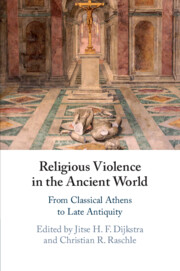Book contents
- Religious Violence in the Ancient World
- Religious Violence in the Ancient World
- Copyright page
- Contents
- Acknowledgements
- List of Contributors
- A Note on Abbreviations
- General Introduction
- Part I Methodology
- Chapter 1 Sacred Prefigurations of Violence: Religious Communities in Situations of Conflict
- Chapter 2 Priestesses, Pogroms and Persecutions: Religious Violence in Antiquity in a Diachronic Perspective
- Part II Religious Violence in the Graeco-Roman World
- Part III Religious Violence in Late Antiquity
- Index of Sources
- General Index
Chapter 1 - Sacred Prefigurations of Violence: Religious Communities in Situations of Conflict
from Part I - Methodology
Published online by Cambridge University Press: 18 September 2020
- Religious Violence in the Ancient World
- Religious Violence in the Ancient World
- Copyright page
- Contents
- Acknowledgements
- List of Contributors
- A Note on Abbreviations
- General Introduction
- Part I Methodology
- Chapter 1 Sacred Prefigurations of Violence: Religious Communities in Situations of Conflict
- Chapter 2 Priestesses, Pogroms and Persecutions: Religious Violence in Antiquity in a Diachronic Perspective
- Part II Religious Violence in the Graeco-Roman World
- Part III Religious Violence in Late Antiquity
- Index of Sources
- General Index
Summary
It was Jan Assmann, with his background in the history of ancient religion, who undertook to clarify the relationship between monotheism and violence.1 He interpreted the remarkable link between Moses and Egypt in the Bible as the faded memory of a reform that was carried out by Pharaoh Akhenaten, who wanted to replace the Egyptian deities with the sun god Ra. Assmann drew a distinction between this exclusive monotheism, which disputed the right of all other gods to exist, and another type of belief in one god, ‘cosmotheism’, which postulated a cosmic ordering as the dwelling place of the gods and goddesses who were worshipped.2 The attempt to permanently replace this type by an exclusive monotheism failed in Egypt; it succeeded only in Israel. The ‘counter-religion’ of Moses was the true religion, in contradistinction to the false worship of gods, and in Israel it was only through violent means that it could be enforced.
- Type
- Chapter
- Information
- Religious Violence in the Ancient WorldFrom Classical Athens to Late Antiquity, pp. 17 - 45Publisher: Cambridge University PressPrint publication year: 2020



